A Guide to Australia’s Best Wildflowers
What comes to mind when you think of Australia? The Great Barrier Reef may get all the attention as one of the world’s great wonders, but what really stands out as an exceptional Australian treasure is something you can find above the waves and throughout the continent. We’re not talking about wide expanse of the Outback or the dramatic arcs of the Sydney Opera house – we’re talking about wildflowers of course!
Bet you didn’t know that Australia is home to over 24,000 species of weird and wonderful native plants! Well, it’s true. Western Australia alone has more than 12,000 species of native wildflowers, more than 60% of which can only be found here and nowhere else on earth.
From fields of wildflowers like the fantastical Everlastings, to what appears to be a floral wreath’s scattered along the red sandy trails, Australia is exploding with wildlife that will shock and awe you whether you’re a native or just passing through.
We’re going to concentrate on the wildflowers in and around WA, considering 12,000 of Australia’s wildflower species are native to this area. The best place to start is Kings Park. One of the world’s largest inner city parks, King’s Park is a 400-hectare botanical garden nestled in the heart of Perth, and it’s one of the best places to see around 1,700 of WA’s native wildflower species. Plus you don’t even have to leave the comfort of the city! Since most of these native plants can be grown locally, and in doing so aid the local ecosystem and our native bees, we encourage you to give some of your favourites from this piece a try.
So if you’re ready for a tour down under and want to check out some of our amazing native flora, read on as we take you through a stack of native wildflowers, their flowering seasons, where you can find them, local tour information, and some excellent links to further your discovery.
Wreath Lechenaultia (Lechenaultia macrantha )

Photo courtesy of Jennie Stock © Image subject to Copyright
Does it look like someone has placed a floral wreath on the ground? We thought so too! But it’s just one of Australia’s unique native plants and it can be found growing wildly in sandy or gravelly soils in Western Australia. The Wreath Lechenaultia spreads to around 1 metre in diameter and about 150 millimetres in height.
The flowers predominantly occur around the outside of the plant between August and November, but this is significantly influenced by the onset of rain.
WA Shires where this plant grows in the wild include:
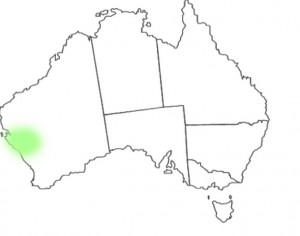
- Dalwallinu
- Greater Geraldton
- Moora, Morawa, Murchison
- Northampton
- Perenjori
- Shark Bay
- Yalgoo
Everlasting Daisies
Everlastings are part of the Daisy family and they grow naturally southern areas of Western Australia and they also extend into South Australia. By themselves in your garden they look great but driving through Western Australia and seeing open fields or woodlands of everlastings in full bloom will make your day or even your year! Each stem supports a single flower which blooms to 60mm diameter. The flowers bloom for a good two weeks and are great for drying as they can last for years. The best types of Everlastings to grow in your garden are:
- Rhodanthe chlorocephala subsp. rosea ‘Rosy Everlasting
- Rhodanthe manglesii ‘Mangles Everlasting’ or ‘Silver Bells’
Everlastings are adaptable and can spring up throughout the year depending on the conditions. Flowering season in WA is usually August to November with the flowering season lasting up to 10 weeks.
Pink and White Everlasting (Rhodanthe chlorocephala)
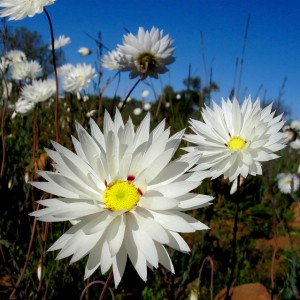
Photo courtesy of Ilena Gecan ( CC )
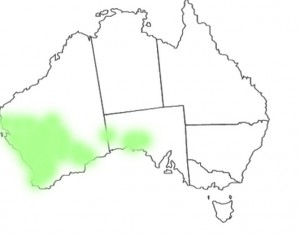
Showy Everlasting (Schoenia filifolia)
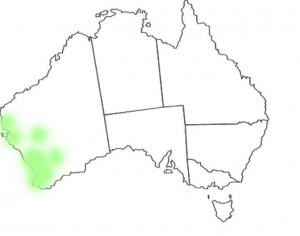
Golden Everlasting (Xerochrysum bracteatum)
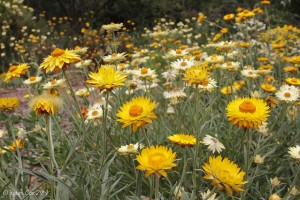

Starflower (Calytrix brevifolia)

Photo courtesy of Bill & Mark Bell(CC)
So far there are about 75 species of native Calytrix in Australia with the majority being located around Geraldton, WA. The most common species is the Calytrix tetragona AKA Fringe Myrtle, can be found growing throughout Australia but the flower colour range is bland compared to the wildflower state, Western Australia, where its Calyrix species have a broad display of colours ranging from white, yellow, pink, purple and to red.
The Calytrix brevifolia is a shrub that grows between 500mm to 2.5m and the flowers appear between August and November. The star-shaped flowers bloom to around 20mm in diameter and the colour is dark pink to magenta with a yellow centre. The Flowers are 15 to 20 mm in diameter and once the petals drop after flowering the colourful sepals or calyces remain long after the flower has gone.
WA Shires where this plant may grow in the wild include:
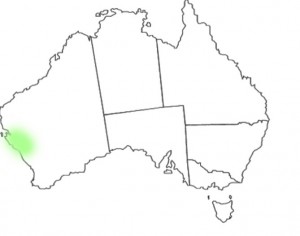
- Chapman Valley
- Greater Geraldton
- Irwin
- Mingenew
- Northampton
- Shark Bay
Green bird flower (Crotalaria cunninghamii)
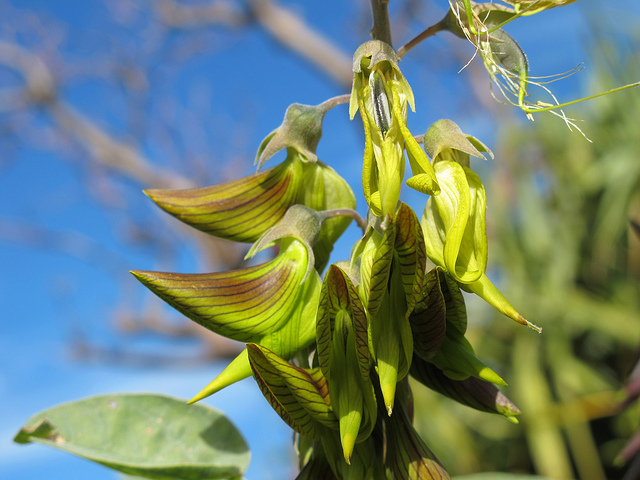
Photo courtesy of Steel Wool(CC)
Another member of the Fabaceae (Pea) family, the Crotalaria cunninghamii is a perennial shrub between 1 and 3m high and its flowers are pollinated by birds and large bees. The flowers resemble birds touching the central stalk with their beak, giving the plant it’s common name “Green Birdflower”. The Green Birdflower can be found in the northern area’s of WA and around central Australia spreading into all mainland states, growing in the hot, arid areas and on unstable sand dunes.
WA Shires where this plant may grow in the wild include:

- Broome
- Carnarvon
- Derby-West Kimberley
- East Pilbara, Exmouth
- Halls Creek
- Karratha
- Murchison
- Port Hedland
- Upper Gascoyne
- Wiluna, Wyndham-East Kimberley
Mulla Mulla (Ptilotus exaltatus)
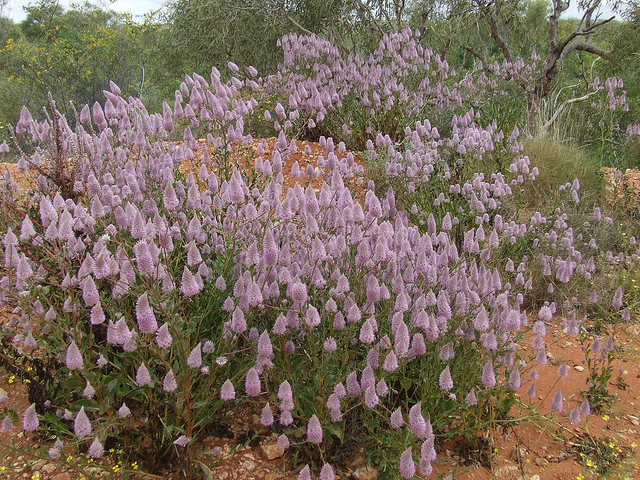
Photo courtesy of Bill & Mark Bell(CC)
With about 100 species of Ptilotus, all but one are endemic to Australia. Ptilotus exaltatus is an annual herb with pink to purple flower spikes and found throughout Australia preferring the hot, arid conditions. Mulla Mulla is also known as Pussy or lamb’s tails due to the appearance of the flowers which can be up to 150mm long and they bloom from July through to December.
A great place to see the Purple Mulla Mulla is the coastal plain of Exmouth Gulf where they thrive in amongst the beautiful wattles.
Good places to see this plant in the wild include:

- Exmouth Gulf Plains
- Yalgoo
- Kennedy Range National Park
- Anywhere hot and Arid
Hammer Orchid (Drakaea Lindl.)
The Hammer Orchid is another one of our 40 weirdest flowers and is crazy looking orchid intent on being pollinated by a specific species of Thynid wasp. This orchid is remarkable, its flower resembles the female Thynid wasp (which by the way is flightless) and it also produces a scent that is very much like the female Thynid wasp’s pheromone!
There are ten species of Drakaea which are all found in Western Australia with 5 of the species being classified as “Threatened” by WA’s Department of Parks and Wildlife. Flowers are usually out between September and December but not every plant will flower.
WA Shires where this plant may grow in the wild include:
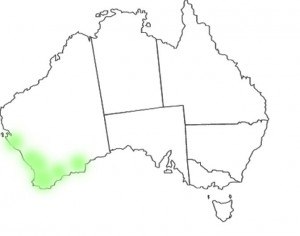
- Albany, Augusta-Margaret River
- Boyup Brook, Bridgetown-Greenbushes, Bunbury, Busselton
- Canning, Carnamah, Collie, Coorow, Cranbrook
- Dandaragan, Denmark
- Esperance
- Gingin
- Harvey
- Jerramungup
- Kalamunda, Kent, Kojonup
- Manjimup, Murray
- Plantagenet
- Serpentine-Jarrahdale
- Wandering, Wanneroo, Waroona, West Arthur
- York
Scarlet Feather Flower (Verticordia grandis)
This is a favourite genus of native flower in our cut flower industry with demand so high that research for farming these plants has been undertaken. There are now 99 recognised species with most of them in Western Australia. The Scarlet Feather flowers have a unique fringed calyx lobe giving the flower a feather-like appearance.
The shrub grows to 1-2 metres with flowers that are around 20-25mm in diameter that usually bloom from September through to January.
WA Shires where this plant may grow in the wild include:
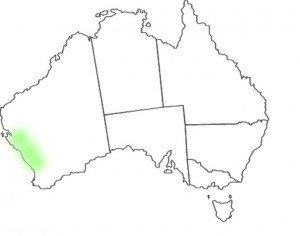
- Carnamah, Chapman Valley, Coorow
- Dalwallinu, Dandaragan
- Gingin, Greater Geraldton
- Irwin
- Mingenew, Moora
- Three Springs
Shark Bay Daisy (Pembertonia latisquamea)
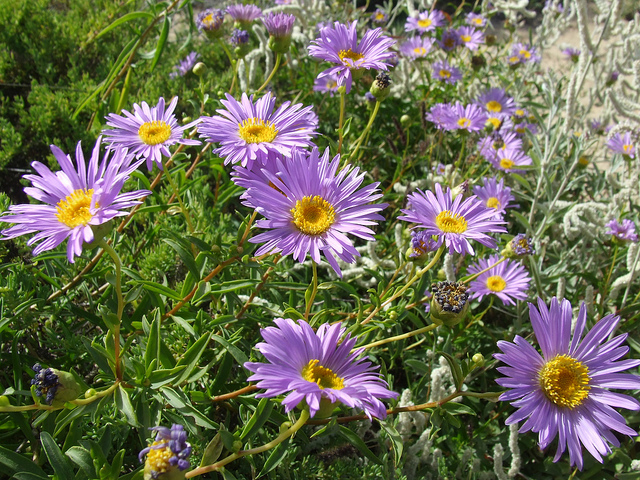
Photo courtesy of Bill & Mark Bell(CC)
A member of the Daisy family, this climbing shrub that grows to around 1.5 metres high and loves deep sandy areas like sand dunes and plains. Flowers grow to around 50mm in diameter and it generally blooms from July to October.
WA Shires where this plant may grow in the wild include:
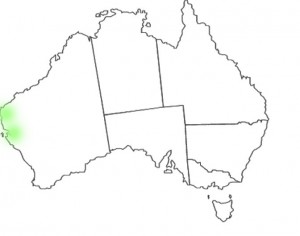
- Carnarvon
- Exmouth
- Northampton
- Shark Bay
Geraldton Wax (Chamelaucium uncinatum)
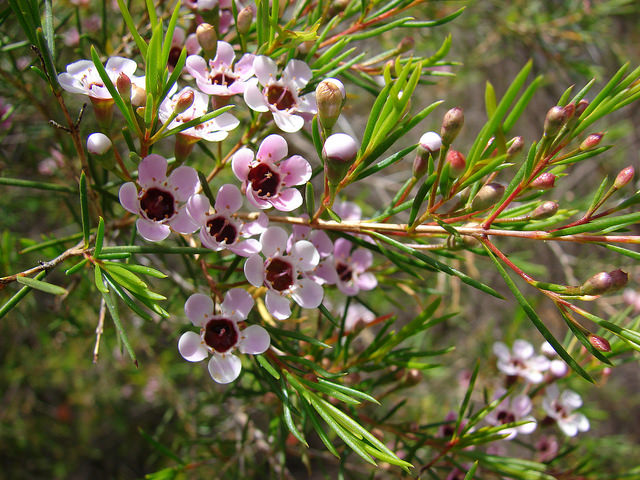
Photo courtesy of Forest and Kim Starr(CC)
This is another favourite flower for our cut flower industry because they last for ages in an arrangement. There are 30 species of the Chamelaucium genus and all are endemic to Western Australia. The Geraldton Wax is relatively easy to grow and many varieties are available commercially. The shrubs typically grow to around 2 metres and flowering season for this plant is between June and November.
WA Shires where this plant may grow in the wild include:
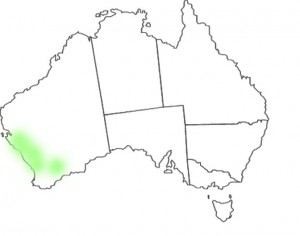
- Armadale
- Carnamah, Chapman Valley, Chittering, Claremont, Coorow, Cottesloe
- Dandaragan
- Fremantle
- Gingin, Gosnells, Greater Geraldton
- Irwin
- Jerramungup, Joondalup
- Manjimup, Melville, Moora, Mosman Park
- Narembeen, Nedlands, Northampton
- Perth
- Quairading
- Serpentine-Jarrahdale, South Perth, Subiaco, Swan
- Wanneroo, Waroona,
- York
Firewood Banksia (Banksia menziesii)
From the Proteaceae family, we have the Banksia with around 170 species and all but one (Tropical Banksia) are native to Australia. Western Australia is the best place to see our diverse range of Banksia with over 150 of our Banksia species only occurring here. Banksia produce a significant amount of nectar critical for our nectar eating wildlife such as bats, native bees, birds and possums. Like other native Australian plants, the Banksia is adapted to bushfires, regenerating quickly after a fire passes through.
The common name “Firewood Banksia” is because of the fast burning properties but it is also known as Firewheel, Flame and Port Wine Banksia. Depending on the climate the Banksia menziesii becomes a gnarled looking tree that grows to around 10m or further north where it is hot and dry you will find the Banksia menziesii growing more like a one to three-metre shrub. Flowering season is between April and August with the flower spikes growing up to 80mm wide, 120mm long.
WA Shires where this plant may grow in the wild include:
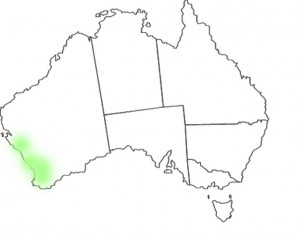
- Armadale
- Bayswater, Belmont, Beverley
- Cambridge, Carnamah, Chapman Valley, Cockburn, Coorow
- Dandaragan
- Fremantle
- Gingin, Goomalling, Gosnells
- Joondalup
- Kalamunda
- Mandurah, Melville, Murray
- Nedlands, Northampton
- Perth
- Rockingham
- Serpentine-Jarrahdale, South Perth, Swan
- Three Springs
- Wanneroo
- York.
Spider Orchids (Caladenia spp.)

Carousel Spider Orchid Photo courtesy of ron_n_beths pics (CC)
The Spider Orchid is a very nice find in the wild and the most spectacular ones can be found in (you guessed it) Southwest corner of WA. The Spider Orchids rely on being pollinated by pseudocopulation similar to the Hammer-orchid where they mimic specific insects or produce particular pollinators pheromones. Australia and WA, in particular, have hundreds of different species of spider orchids, natural and hybrids with more being discovered all the time.
Different species tend to be in different regions and we have listed a few below.
The Carousel Orchid (Caladenia arenicola)
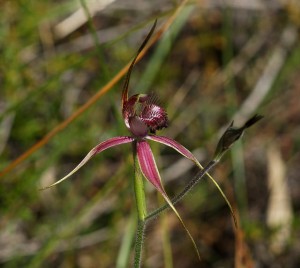
Photo courtesy of ron_n_beths pics ( CC )
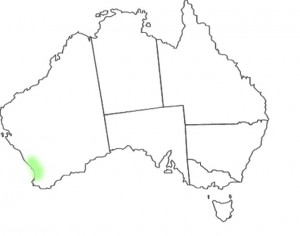
Cape Spider Orchid (Caladenia caesarea subsp.maratima Hopper & A.P.Br) is currently endangered.
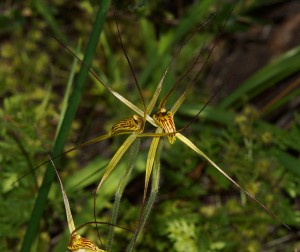
Photo courtesy of ron_n_beths pics ( CC )

Clubbed Spider Orchid (Caladenia longiclavata)
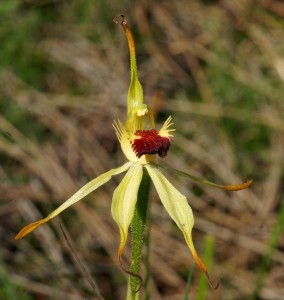
Photo courtesy of ron_n_beths pics ( CC )

The Blood Spider Orchid (Caladenia filifera)
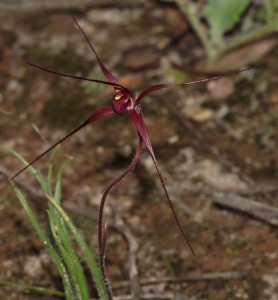
Photo courtesy of ron_n_beths pics ( CC )

Karri Spider Orchid (Caladenia brownii)
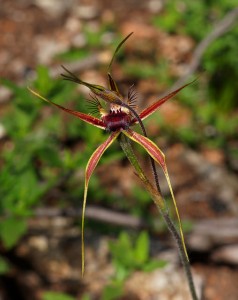
Photo courtesy of ron_n_beths pics ( CC )

Triggerplants (Stylidium spp.)

Stylidium eriopodum Photo courtesy of ron_n_beths pics (CC)
Western Australia has over 150 species of triggerplants which are endemic to Australia. The Stylidium is diverse in shapes and sizes with some species growing to 1800mm high and others creeping across the ground. The flowers vary in shapes and sizes too, are symmetrical like a face and they have a sneaky way of being pollinated. From the throat of the flower protrudes a trigger which is activated when an insect lands on the flower. Once the flower detects pressure, the trigger harmlessly strikes the insect, covering it in pollen. The strike of the trigger is fast, 15 milliseconds, after a while it will reset and wait for the next visitor.
Stylidium fluminense
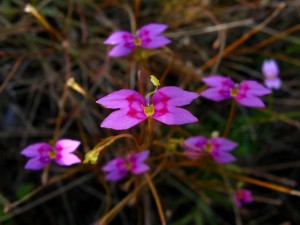
Photo courtesy of Ilena Gecan ( CC )
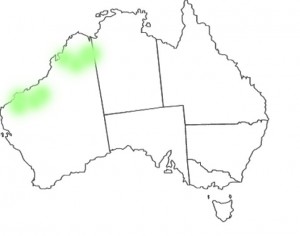
Queen Triggerplant (Stylidium affine)
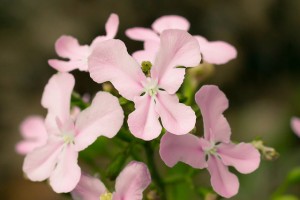
Photo courtesy of Ilena Gecan ( CC )
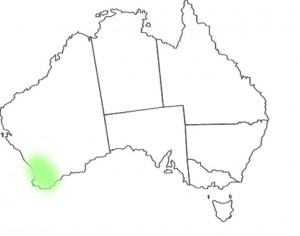
Book Triggerplant (Stylidium calcaratum)
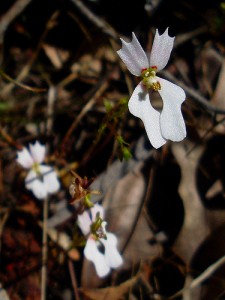
Photo courtesy of Ilena Gecan ( CC )

Posy Triggerplant (Stylidium crossocephalum)
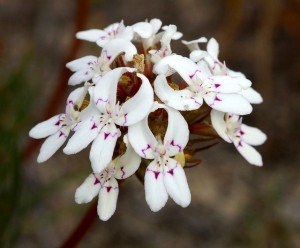
Photo courtesy of ron_n_beths pics ( CC )
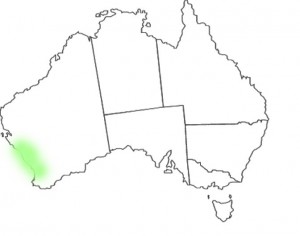
Boomerang Triggerplant (Stylidium eriopodum)
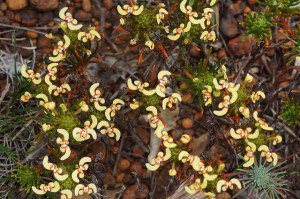
Photo courtesy of ron_n_beths pics ( CC )
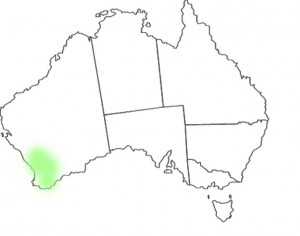
Pink Fountain Triggerplant (Stylidium brunonianum)
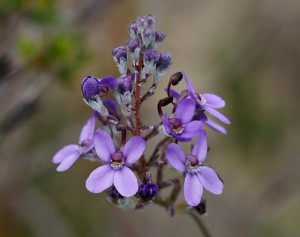
Photo courtesy of ron_n_beths pics ( CC )
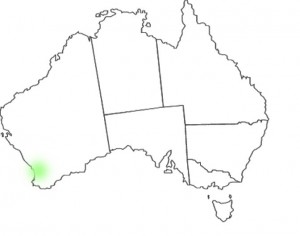
Sturt’s Desert Pea (Swainsona formosa)
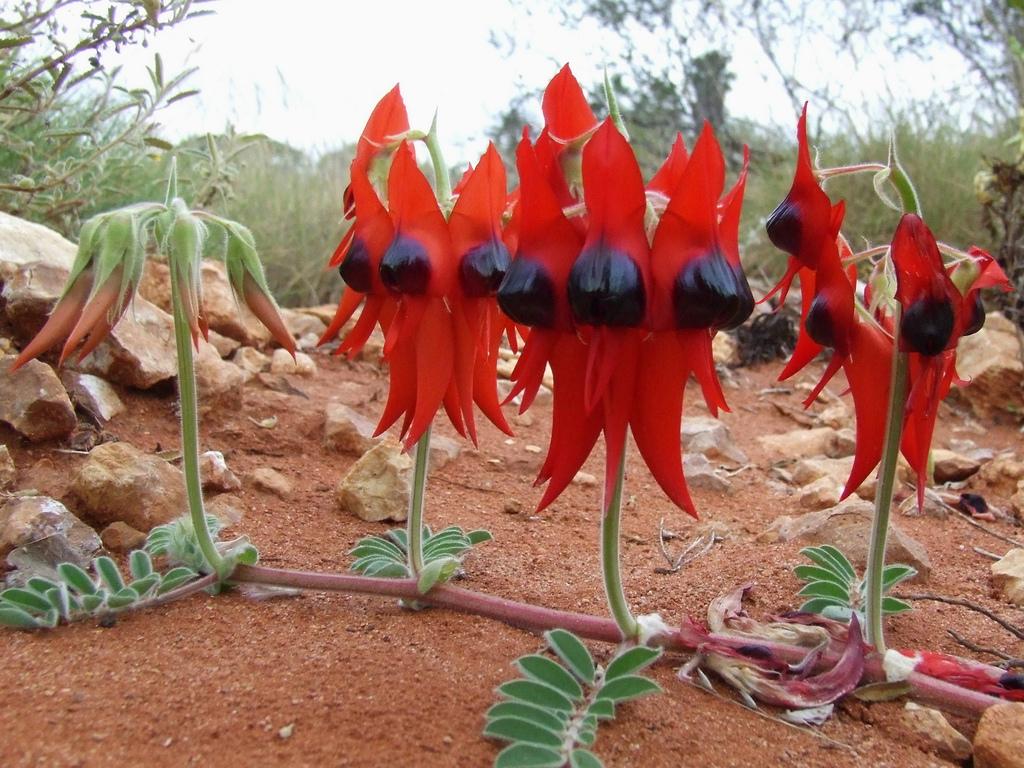
Photo courtesy of Bill & Mark Bell(CC)
This unique flower made it into our 40 of the Worlds Weirdest Flowers and as the name suggests this plant is indeed a member of the Pea (Fabaceae) family.
South Australia adopted the Sturt’s Desert Pea as their floral emblem in 1961; it is also illegal to collect or pick the plant from Crown land unless you obtain a permit. The plant is generally treated as an annual, only lives for one year but grafted Sturt desert peas have been successful are expected to live three times as long.
Sturt’s Desert Pea is native to Australia; it grows naturally in most mainland states except for Victoria. The flowers are around 90mm long and is adapted to being pollinated by birds. Flowering occurs from July to March, but this is significantly influenced by the onset of rain.
Locations where this plant may be found in the wild include:
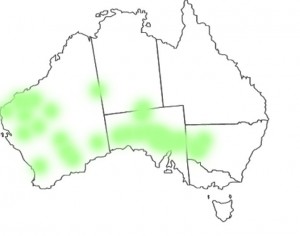
- Flinders Ranges, SA
- Glendambo, SA
- Pilbara, WA
- Kalgoorlie, WA
- Frazer Range, WA
- Karratha, WA
- Finke, NT
- Alice Springs, NT
- Kings Canyon, NT
- Sturt National Park, NSW
Royal Bluebell (Wahlenbergia gloriosa)

Photo courtesy of natureshare/ ( CC )
The Royal Bluebell was chosen as the official floral emblem of the ACT in 1982. In the wild the Wahlenbergia gloriosa generally only grows above 1300 metres throughout the mountain ranges (Australian Alps) from the Australian Central Territories, south-east mountains of New South Whales and across the border to the Eastern mountain forests of Victoria. There are twenty-one species of Wahlenbergia in Australia with nineteen of them growing throughout NSW. Wahlenbergia gloriosa is often mistaken for the Wahlenbergia gracilis (Australian Bluebell) because of the similar appearance and it’s more commonly found throughout NSW and VIC.
The Royal Bluebell is a frost tolerant ground-covering, perennial herb with 20 to 30mm diameter flowers appearing between October and March.
Locations where this plant may be found in the wild include:

- Namadgi National Park, NSW
- Mount Hotham, Vic
- Kosciuszko National Park, NSW
- Alpine National Park, Vic
Waratah (Telopea speciosissima)
The Floral Emblem of New South Wales, the Waratah a shrub which grows between two and four metres with beautiful crimson flowers grouped into a rounded head with matching crimson bracts. The Waratah flowers produce vast amounts of nectar, very familiar with birds and the cute little Eastern Pygmy Possum. The Waratahs are cultivated in the Dandenong Ranges of Victoria and north of Sydney and they are also grown commercially in places like New Zealand, Hawaii and Israel for the cut flower industry due to their popularity in floral arrangements. There are four species of the Telopea with two being found only in NSW, one in Tasmania and the other extending between Victoria and NSW.
Flowers are around 70 to 100mm in diameter and generally appear between August to November and possible spot flowering around March depending on conditions.
Locations where this plant may be found in the wild include:
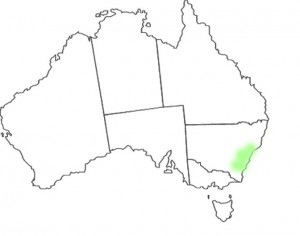
- Ku-ring-gai Chase National Park
- Brisbane Water National Park
- Dharug National Park
- Macquarie Pass National Park
Pink Common Heath (Epacris impressa)
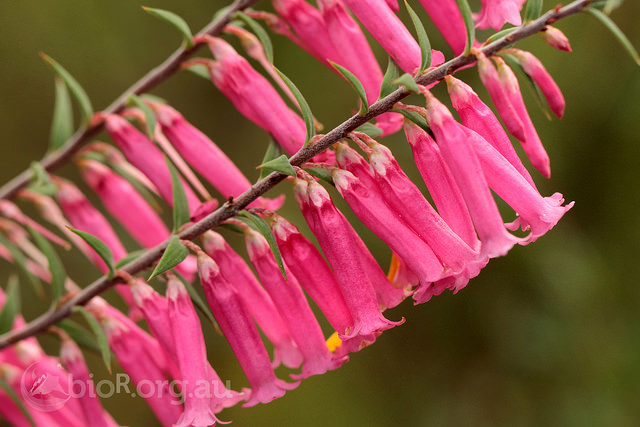
Photo courtesy of BioR Australia(cc)
Slightly jealous of all the other states floral emblem names as ours sounds a little underwhelming “Common Heath” but don’t let the name put you off as this plant is far from common. These small, slender shrubs flowers were officially named the floral emblem of Victoria in 1958 There are around forty species of the Epacris, most of them are found in south-eastern Australia and just like our pavlova, the Kiwis have decided to claim a few species as New Zealand natives. There are many different coloured Common Heaths, ranging from Pure white, light pink, dark pink, crimson to scarlet.
Flowering season is around May to October with 25mm tubular flowers.
Locations where this plant may be found in the wild include:
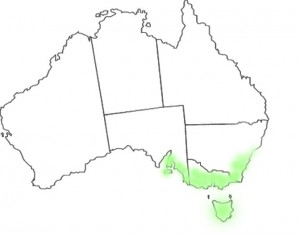
- Grampians National Park, Vic
- Mount Lofty Ranges, SA
- Around the Clyde River, NSW
- Throughout Tasmania
Sturt’s Desert Rose (Gossypium sturtianum)
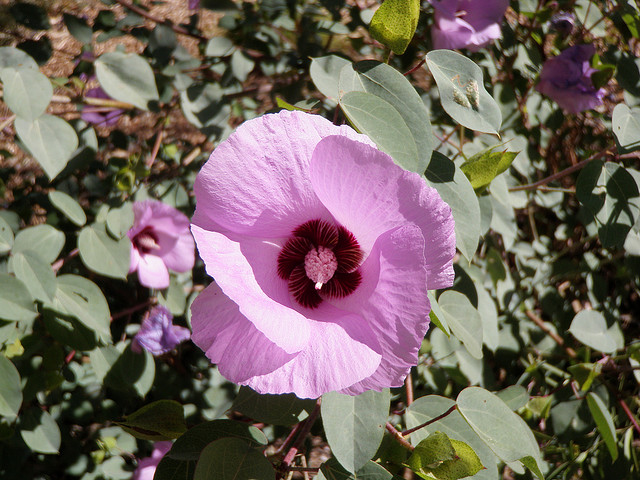
Photo courtesy of Natalie Tapson(cc)
In 1961, the Northern Territory proclaimed the Desert Rose as its floral emblem however the original name was Cienfugosia gossypioides and that has since been replaced by the Gossypium sturtianum. In 1978 when the NT changed to self-government they incorporated the Desert rose into the design of NT flag. There are four species of the Gossypium genus that produce cotton, G.hirsutim ,G. herbaceum , G. arboreum and G. barbadense. Unlike the fore mentioned cotton producing species, our Gossypium sturtianum seeds do contain hairs but they are useless as cotton fibre. The Gossypium sturtianum flower looks like a hibiscus flower which is one of the Desert Roses nearest Australian Cousins. A drought tolerant shrub which can grow to two metres the Sturt’s desert rose does not have a set flowering period but peak flowering is generally around August to September.
Regions where this plant grows in the wild include:
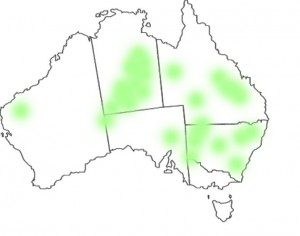
- Burt Plain
- Central Ranges
- Davenport Murchison Ranges
- Finke, Flinders Lofty Block
- Great Sandy Desert
- MacDonnell Ranges
- Pilbara
- Tanami
Cooktown Orchid (Dendrobium phalaenopsis or Vappodes phalaenopsis)

Photo courtesy of ANBG, M. Fagg photographer(cc)
The Cooktown Orchid was chosen as Queensland floral emblem in 1959, runner up was the Grevillea banksii. There is a little bit of debate and speculation over the correct species name because in 1959 the Cooktown Orchid was known as the Dendrobium bigibbum. However it is now also known as Dendrobium phalaenopsis or the latest name, Vappodes phalaenopsis. The Cooktown Orchid tends to form on rocks and trees with stems growing to 1200mm and the arching flower stems grow to around 400mm. The flowers vary from 30 to 70mm, which are larger than the original Dendrobium bigibbum. The Orchid is considered endangered and confined to the east side of Cape York Peninsula to as far north as the Iron Range.
Flowers appear from February to October with the peak flowering period being March to August.
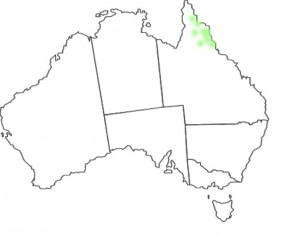
- Cooktown
- Rinyirru National Park
- Endeavour River Valley
Red and Green Kangaroo Paw (Anigozanthos manglesii)

Photo courtesy of Bill & Mark Bell(CC)
The green and red Kangaroo Paw is also known as the Mangles Kangaroo Paw. This species of Kangaroo Paw can only be found naturally in Western Australia. On the 9th of November, 1960 Western Australia adopted the Red and Green Kangaroo Paw as its floral emblem and like the Sturt Desert Pea in South Australia, you need a licence to collect this plant from the wild.
Between August and November, you can see these magnificent Paws standing tall all around Perth.
WA Shires where this plant may grow in the wild include:

- Armadale, Augusta-Margaret River
- Boyup Brook, Busselton
- Capel, Chittering, Cockburn, Coorow
- Dandaragan
- Gingin, Gosnells
- Kalamunda, Kojonup
- Manjimup, Melville, Mundaring, Murray
- Northampton
- Perth, Plantagenet
- Serpentine-Jarrahdale, Shark Bay, Stirling, Subiaco, Swan,
- Wanneroo, Waroona, West Arthur, Williams
- York.
Tasmanian Blue Gum (Eucalyptus globulus)
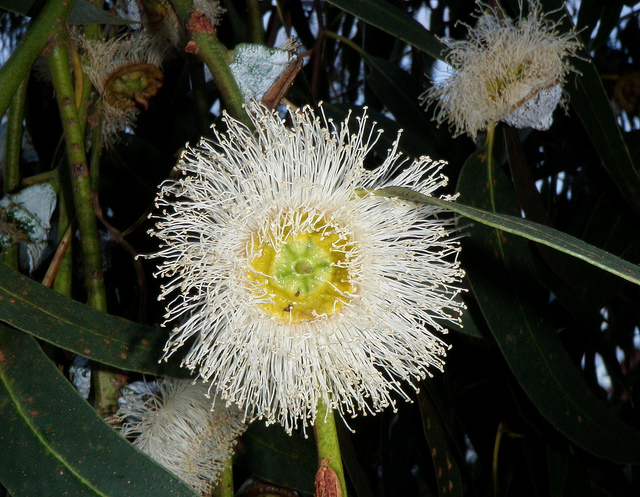
Photo courtesy of Natalie Tapson(cc)
Tasmania’s magnificent Blue Gum is a monster of a tree that can grow up to seventy metres with two metres of trunk diameter. It was in 1962 that the Tasmania Blue Gum was selected to be the State’s floral emblem. The flowers produce lots of nectar are an important source of food for our Native critters but also bees foraging on these flowers make a distinctive tasting honey. The Eucalyptus globulus is cultivated throughout Australia and places all around the world like Brazil, France, India and Spain. In California, it is so well established that many Californians assume that it is native to their area and is listed as an invasive plant by the California Invasive Plant Council.
Locations where this plant may be found in the wild include:
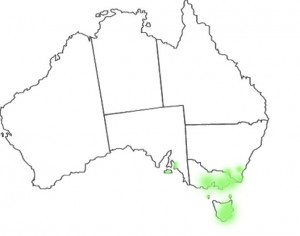
- East Coast of Tasmania
- Bruny, King, Flinders and Cape Barren Islands
- Strzelecki Ranges-Wilsons Promontory, Vic
- Otway Ranges
- California, US
Golden Wattle(Acacia pycnantha)
The Golden Wattle is our national floral Emblem, green and gold! The Golden Wattle withstands our droughts and bushfires and its resilience represents The Australian people. The Golden Wattle is also a symbol of Unity and is now being embraced as a symbol of remembrance. 1901 the Golden Wattle was unofficially the National floral emblem but there was strong opposition to having the Waratah instead. On September the 1st, 1988 the Acacia pycnantha was finally proclaimed as the National Floral Emblem and four years later, the 1st of September was officially National Wattle day.
Springtime sees the Golden Wattle blooming with its fluffy flower heads and up to eighty tiny sweet smelling flowers proudly displaying the national colours.
locations where this plant may be found in the wild include:
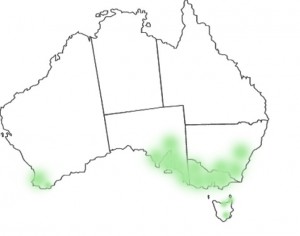
- Eyre Peninsula, SA
- Flinders Ranges, WA
- Western Victoria
- Southern inland NSW
- Around Canberra of course.
Are you feeling inspired yet? Good!
Most of the native plants featured in this piece can be grown in our very own gardens and yards! So if you’ve got a green thumb or are just curious, give it a go and plant some native wildflowers.
Remember that by growing native plants we are helping our native wildlife, especially our native bees! Give nature a hand and plant some native flowers already.
Further information on WA Wildflowers:
- https://www.wa.gov.au/ for advice, links, and what’s happening in Western Australia
- Click here for an excellent downloadable wildflower guide to Western Australia
- Check out Australia’s Coral Coast for wonderful self-drive tours, maps and a run down on what’s flowering.


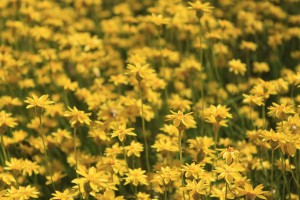
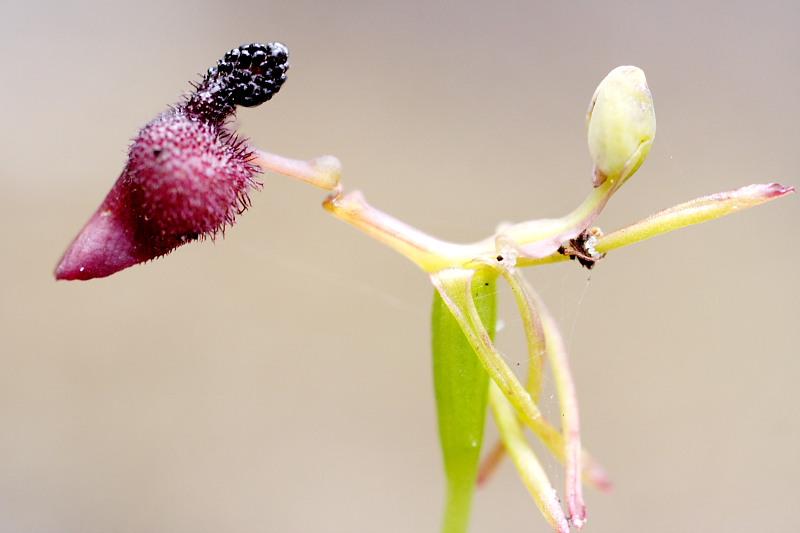
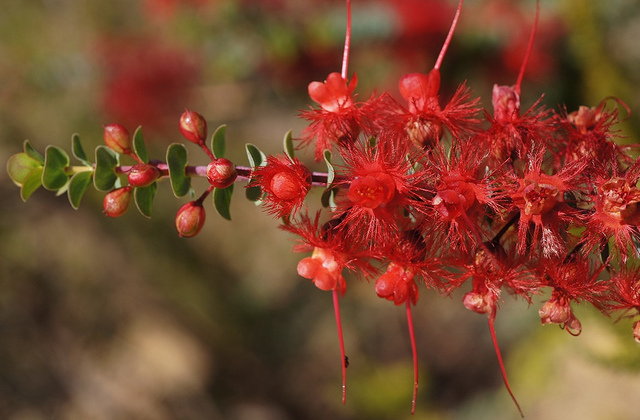
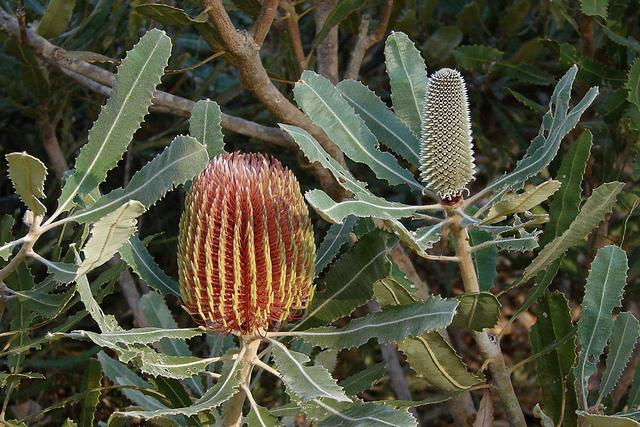
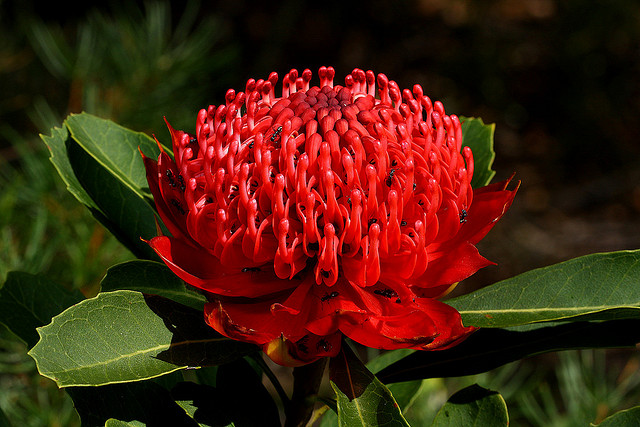
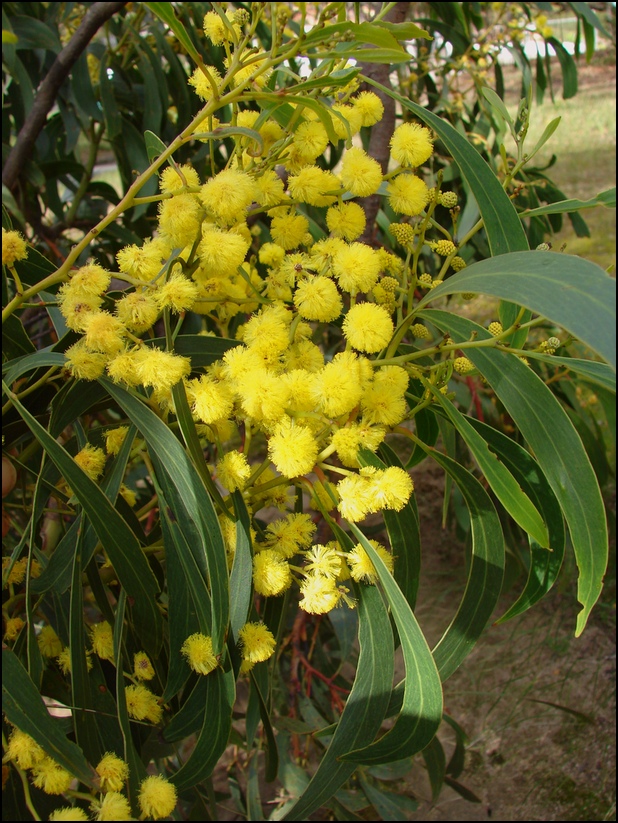
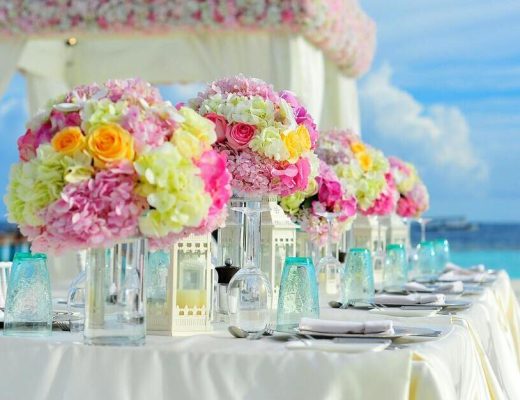


17 Comments
Pandharinath Mhaske
January 26, 2016 at 1:14 amThanks for sharing lots of photos and info of Australian wildflowers. I’m really pleased this morning on our Republic Day and the feature write up is on the occasion of Australia Day. I am fortunate to have seen a handful few of them with visit and flower arrangement demo by Richard Go in Mumbai-India three years ago.
-Secretory Pune Florists Association. Pandharinath Mhaske
Justin Hughes
January 26, 2016 at 1:33 amHappy 67th Republic day, and Australia Day to you Pandharinath! Thank you for the kind words. Richard Go is a fantastic floral artist and he really knows how to manipulate flowers into works of art. I wish you the best in the celebrations of Republic day and the ceremonial parade.
Tatiana Gerus ('Tatters' in Flickr)
January 26, 2016 at 11:35 amWhat a wonderful collection!
Informative too!
Thank you , and Happy Australia Day!
Justin Hughes
January 26, 2016 at 6:20 pmHi Tatiana, Thank you for the compliments and for letting us use a few of your awesome photo’s from your massive collection of Australian Flora and Fauna.
Janet Atkins
February 5, 2016 at 8:20 amThe golden wattle Acacia pycnantha is not native to West Australia -it is a serious environmental weed
Justin Hughes
February 5, 2016 at 10:50 pmHi Janet,
Yes, you are 100% correct, our National Flower is a problem weed! I would have voted for the Waratah as the National Flower instead of the Golden Wattle.
The Acacia pycnantha is not native to WA, but it has now made itself at home there. The Acacia pycnantha is classed as a weed in Western Australia, Tasmania, area’s around NSW where it is not Native and also a real problem in South Africa.
Thank you for pointing that out.
Justin
Jonathan
May 19, 2016 at 1:59 pmVictoria has the most beautiful flowers in the world! The Waratah flower is the best. I’ve seen it around Melbourne.
Jennifer lyon
October 7, 2016 at 11:54 amBravo! for an informative overview of Australia’s wildflowers.
I have been transfixed by the wreath flower, having just returned from a discovery trip to the Northwest area of WA.
I will return. They are spellbinding
Justin Hughes
October 18, 2016 at 5:12 amI am jealous Jennifer! I have yet to see a real live Wreath Flower! Did you see any other wildflowers on your travels?
Janine
November 27, 2016 at 1:45 amThis is a lovely collection of pictures and information. I have been looking everywhere for something on a roadside flower (also found on nature strips and in gardens) which grows in New South Wales (at least). It grows to between perhaps 30 and 40 cm. with very slender leaves growing close to the stem The flowers are extremely pretty – being tiny (to about 1 cm overall diameter); star-shaped and pale blue. They always close in the afternoon. I always mow around them (but then I also do that sometimes with a few of the dandelions too!). Thanks in advance if you can help! Cheers from NSW.
Justin Hughes
November 28, 2016 at 1:39 amHi Janine, thanks for your lovely comments 🙂
I also like to mow around the nature strip flowers or at least wait until the pollinators have finished with them.
The mystery blue flowered plant sounds like a native bluebell (Wahlenbergia species)
Possibly Wahlenbergia stricta,Wahlenbergia gracilis or Wahlenbergia communis. Take a look and see if it is one of those and please let us know. If anyone else can help, please feel free to add to this conversation 🙂
Kalina Masarz
September 9, 2018 at 12:20 amI miss my Australian Trees so much . Greetings from Poland and Thank You for nice beauty collection .
Waterwise
February 21, 2019 at 10:57 pmThose wildflowers are beautiful. The great thing about them is they can thrive in the harsh Australian climate without human intervention. Nature never ceases to amaze.
Fancy Plants Nursery
April 15, 2019 at 11:39 pmThanks for the information. sounds so great and helpful. Kudos!
nick
June 20, 2019 at 9:50 amFantastic images and text. I love your work here. Bravo!
Brenda M Sanchez
June 27, 2019 at 5:19 amcan these plants and flowers be bought from you ?
Alessio’s Gardens
April 15, 2021 at 4:21 pmThanks for sharing this amazing post here!